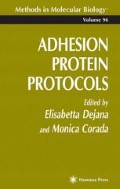Abstract
Immunohistochemistry or immunofluorescence analyses are ideal techniques for localizing adhesive molecules in organs and tissues if reliable, well-characterized antibodies are available. In situ hybridization with RNA probes represents an alternative method for detecting mRNA encoding adhesive proteins (1). In comparison to immunological methods, in situ hybridization is more time-consuming and has a lower resolution at the cellular level. However, it is the method of choice if cloned cDNA probes for adhesive molecules have been isolated, but suitable antibodies are not available. Furthermore, in situ hybridization is often more sensitive than immunological methods and, thus, allows the detection of adhesive molecules that are expressed at low levels. Finally, the detection of mRNA allows their inambiguous determination of the site of synthesis of secreted molecules or of molecules whose extracellular domains can be proteolytically processed, and that, on release from their producer cells, may travel to distant locations in the tissue (2).
Access this chapter
Tax calculation will be finalised at checkout
Purchases are for personal use only
References
Breier, G., Breviario, F., Caveda, L., Berthier, R., Schnürch, H., Gotsch, U., Vestweber, D., Risau, W., and Dejana, E. (1996) Molecular cloning and expression of murine vascular endothelial cadherin in early stage development of cardiovascular system. Blood 87, 630–641.
Steffen, B., Breier, G., Butcher, E. C., Schulz, M., and Engelhardt, B. (1996) ICAM-1, VCAM-1 and MAdCAM-1 are expressed on choroid plexus epithelium but not endothelium and mediate binding of lymphocytes in vitro. Am. J. Pathol. 148, 1819–1838.
Hogan, B., Beddington, R., Costantini, F., and Lacy, E. (1994). Manipulating the Mouse Embryo: Laboratory Manual. Cold Spring Harbor Laboratory Press, Cold Spring Harbors, NY.
Sambrook, J., Fritsch, E. F., and Maniatis, T. (1989). Molecular Cloning: a Laboratory Manual. Cold Spring Harbor Laboratory Press, Cold Spring Harbor, NY.
Author information
Authors and Affiliations
Editor information
Editors and Affiliations
Rights and permissions
Copyright information
© 1999 Humana Press Inc.
About this protocol
Cite this protocol
Breier, G. (1999). In situ Hybridization with RNA Probes. In: Dejana, E., Corada, M. (eds) Adhesion Protein Protocols. Methods in Molecular Biology, vol 96. Humana Press. https://doi.org/10.1385/1-59259-258-9:107
Download citation
DOI: https://doi.org/10.1385/1-59259-258-9:107
Publisher Name: Humana Press
Print ISBN: 978-0-89603-417-4
Online ISBN: 978-1-59259-258-6
eBook Packages: Springer Protocols

